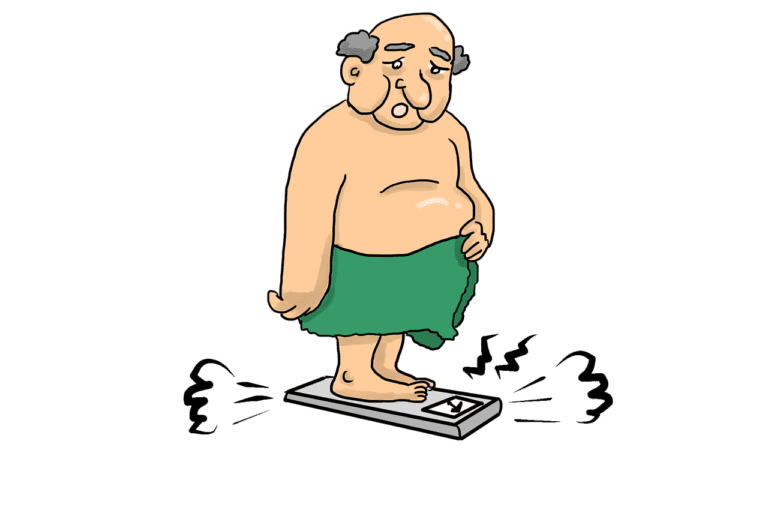For people who are skinny fat intermittent fasting is an interesting diet: it promises to improve your metabolism, helping you lose fat. But then there’s an issue: most of these benefits are proven on people who are overweight. But the truth is, skinny fat is an entirely different category. You’re not overweight, so technically you don’t need to lose weight. But you have no muscle definition, instead, you have a lot of fat, so there’s more work to be done.
Don’t worry! There’s a way to improve your look and your health, and intermittent fasting can help. So keep reading this article, if you want to find out how it can help you and what else you need to do for success.
What is skinny fat?
Skinny fat is a popular term that described those who are thin but still have plenty of fat on their body. It isn’t a medical term, but rather a colloquial one, to describe a particular body shape.
It is most common with people who are thin no matter what they eat, who never seem to put on much weight even though they never exercise or watch what they eat.
Don’t let that fool you though! You can become skinny fat even if you start as obese. Following the wrong diet and doing the wrong exercise, or even exercising too little while losing weight, can help you become skinny fat.
Because we’re used to thinking if we get to a certain BMI (body-mass index) or a certain number on the scale we’re automatically healthy, we may fall into a common trap: believing being skinny fat has no health risks.
The main risks come precisely from the fact that many people with this type of body composition can and will eat anything they want. And that does not usually include healthy foods. So risks of metabolic disorders, including type 2 diabetes, increase quickly.
If on top of a bad diet, there’s also the issue of doing little to no exercise, there are other risks at hand, including muscle and bone density loss.
How do I find out if I am skinny fat?
A body composition analysis can help you find the fat percentage in your body. This percentage, compared to your weight, will tell you if you’re close to ideal body composition or if, on the contrary, you’re skinny fat.
But there are a few signs that you can see for yourself quite easily without ever finding your body fat percentage.
For instance, if despite being thin, you have a muffin top, it is a sign you’re skinny fat. Studies have shown belly fat is bad even at a normal weight. It puts you at greater risk for high cholesterol, elevated triglycerides, diabetes, and m0re.
In terms of workout, if something simple like a push-up or a few bodyweight squats are a challenge, it is another sign your body composition is not the best.
If you know you don’t eat a healthy diet, eat a lot of carbs and sugars, and are still skinny, you can bet you’re the thin-fat type. Exercise may help, but if you do little or only do cardio, it won’t do much to change your body composition.
Finally, if you have a family history of diabetes or heart conditions, regardless of their weight, you want to pay special attention to the fat percentage in your body, as you’re more likely to fall into the skinny fat category.
How can intermittent fasting help skinny fat people?
One thing many skinny fat people have in common is a huge appetite and a difficulty cutting calories in normal diets. This is where intermittent fasting can be extremely helpful. By shortening the eating window, you are automatically removing 1 meal from your day. If you eat normally and avoid binging during the rest of the day, you are already on your way to weight loss.
Now because as a skinny fat person, you want to lose fat, not weight, you’ll need to also manipulate your macros and make sure you eat a lot of proteins and reduce your carbs. Add to that a good workout routine, aimed to help you build muscle, and you’ll start seeing changes in your body composition quicker than you’d expect it.
And there’s another advantage. Training in a fasted state will help you burn fat quicker. So all you need to do is adjust your daily schedule and make sure you work out sometime in the morning before you have your first meal. Do remember exercising on an empty stomach is not something everyone can do. If you know you get hypoglycemic easily, you may want to be careful with the type of effort you’re making. Or at least, workout close to your first meal. That way, if you realize you don’t feel great during your workout, you can simply stop and eat, without braking your fast much earlier than normal.
Intermittent fasting is also great for people with a huge appetite. Research on circadian rhythm and hunger shows that people’s appetite is at its lowest in the morning. That’s precisely what makes intermittent fasting the perfect diet for people who feel they can’t reduce calories throughout the day. You simply skip breakfast, then go on eating as much as you normally would at the other meals.
If your appetite is more atypical and you find yourself hungry in the morning there are 2 fixes you should consider. First, eat more at dinner. Especially if you plan on abstaining from food for a minimum of 16 hours, it’s ok to have a bigger last meal at the end of the day. If this doesn’t work, the second option is to move your eating window. Start eating as soon as you wake up, and stop after at most 8 hours. Fast for the next 16 minimum, then start again.
Do remember it may take some time for your body to adjust to your new diet. Whichever option you chose, make sure you give yourself at least 1-2 weeks to see if your body adjusts before changing the fasting method.
What is a good workout for skinny fat people?

When it comes to working out, the best thing you can do if you’re skinny fat is to focus on strength training. That doesn’t mean completely cutting cardio out, but the majority of your workouts should be comprised of exercises meant to build muscle.
Strength training, specifically weight lifting, will help you build lean muscle mass. Now lean muscles will help you in turn burn more fat during the day, by increasing your basal metabolic rate.
If you’re a complete beginner, you can start working out 3 times per week. Choose smaller weights at first. There’s no point going for the heaviest in an attempt to get faster results. You’re more likely to get injured and be forced to stay away from the gym for a few weeks or more. A good weight is one that will allow you to do 10-15 repetitions. By the time you reach the last ones, you should feel it is difficult. If you reach the 15th rep and you feel you could still do a lot more, the weight was too light.
In terms of how to divide the workouts in 3 days, you can start by one lower body/leg day. On the other 2 days, you can divide the upper body, for instance in pull and push days. In the pull-day, you’ll work out the biceps, the back, while the push day will be dedicated to the triceps, chest, and shoulders. You can work your core on any of those days.
If you don’t have access to a gym and heavyweights, bodyweight exercises in a high-intensity interval training style can be very helpful.
Once your 3 days a week routine starts to become easy, you can increase to 4-5 days. This is considered ideal for building muscles and seeing fast results. But, if you don’t have time due to your job, or other commitments, the 3 days routine can help. You’ll just need to be a bit more strict with your exercises and your diet.
A word on cardio
We can’t talk about working out without mentioning cardio at all. If you’re skinny fat, you want to limit that as much as possible. If it is something you enjoy as a hobby, such as riding a bike in the park with friends, or maybe you use the bike as a means of transportation, stick to that. Don’t add any more cardio to your workout routine.
If you have a sedentary lifestyle, then you can add a short cardio session here and there, maybe once a week. However, the best way to do some cardio and still see quick results is to use it simply as a warm-up. For instance, you can run on the treadmill for 15-20 minutes before your workout. Make sure you don’t exhaust yourself in the process though. Remember that weight lifting is your focus, so the cardio should merely help you warm-up, not leave you without energy.
Some recommend doing a quick calisthenics workout and leaving any cardio for the end of the strength training session to prevent precisely this risk. In this way, you build muscle, and in the end, you do about 15 minutes of cardio to burn more fat. This is, however, not mandatory, and can be skipped altogether, especially if you’re a beginner. As you become more advanced and start gaining strength, you may think of ways to maximize your gains and play with adding cardio to your sessions.
What are the downsides of intermittent fasting for skinny fat people?
Every diet and every lifestyle has its pros and cons, and intermittent fasting is no different. For people who are skinny fat intermittent fasting comes with a few risks: undereating, not paying attention to macros, and binge eating.
Undereating
Undereating is a risk that comes with intermittent fasting because depending on the method you’ve chosen you’re skipping 1 or 2 meals a day. And because during the eating window the general recommendation is to avoid binge eating, you’re naturally cutting calories. That’s all great, but if you purposefully start cutting calories and try to eat less than you need to during your eating window, you’ll soon end up undereating.
Don’t fall into the trap of believing that will give you quicker results. It might shock your body in the beginning and you could lose some fat. But that can quickly backfire and you risk to start losing muscle. That’s because your body needs some form of energy and fat, like it or not, is energy. So your body might be inclined to hold on to that rather than the muscle. Which is not exactly the effect you want!
To avoid that, make sure you’re eating enough during your eating window. You should feel satisfied and it should be easy to go about your day to day activities without constantly craving food or thinking about your next meal. If you find yourself getting dizzy, fatigued, or if you get symptoms of hypoglycemia, it’s a sign you’re eating too little.
Not thinking about your macros
Because intermittent fasting isn’t a diet with clear instructions on what to eat, you might think you’ll see results regardless of what you put on your plate.
First, start by lowering your carbs. I’m not saying you need to go all the way to the lowest carb diet possible. See how many you’re currently eating and try to gradually reduce by 20-30 grams per week, for instance.
The next step is to eliminate junk food. This will help with the previous step because usually, most junk food is extremely high in carbohydrates. If you also eliminate or reduce pastries and desserts loaded with sugar and replace them with fruits, veggies, nuts, and seeds, your macros will look a lot better.
Now you can think of replacing the carbs you removed with lean protein and healthy fats. Skipping a meal might also mean the ideal muscle-building protein quantity is more difficult to reach. That can be easily fixed though, by supplementing with a protein shake. These usually taste sweet, so if you’re the type that loves a sweet treat in the middle of the day, or in between meals, you’ll find protein shakes are the perfect replacement for those snacks.
In other words, remember that just because you’re cutting 1 or 2 meals a day, or eating fewer calories, it doesn’t mean you can eat anything you want. A diet high in carbs and especially sugars will not help you fight the skinny fat body composition, quite the contrary.
Binge eating
Intermittent fasting diets don’t usually tell you how much to eat. Because even in its simplest form, the 16:8 method, most people will cut out one meal, eating at a calorie deficit is easy. However, some end up binge eating during their eating window. Whether that’s because they are in a hypoglycemic state which messes up their hunger cues, or simply because they think they can eat as much as they want, the end is the same: they eat way over their limit and end up gaining weight.
I’m sure you realize, even as a skinny fat person, this is something you need to avoid. There are diets made to help you bulk, and they will usually be chosen by those who are trying to rapidly gain muscle. However, there are two factors here: these diets have very specific macros that ensure you truly gain muscle, not fat and they are combined with a strict workout regime. In other words, they are different from binge eating, where you simply eat in a fairly uncontrollable manner.
How long does it take to get rid of skinny fat when you do intermittent fasting?
This depends on several factors such as:
- your macronutrient ratio;
- how much you exercise;
- the type of workouts you do.
It also depends on your dieting history. If you’ve been on crash diets in the past, you may find results come slower. However, if this is your first time trying any type of diet, results will probably start showing rather quickly.
Muscle takes longer to build though, so don’t expect to see a lot of muscle definition earlier than 6-8 weeks. Remember you always want to aim for progress, not perfection. So as long as you see a positive change in your body, know you’re on the right track,
Bottomline
Being thin doesn’t equate health. A thin fat type of body, with a lot of fat around the midsection, has plenty of health risks, such as cardiovascular disease, type 2 diabetes, and more. Diets can be difficult when you’re already at a healthy weight, especially if you have a big appetite and are used to eating everything you want without gaining weight.
For people who are skinny fat, intermittent fasting can be the solution. It is a diet fairly easy for most, regardless of their appetite, and with a few tweaks to adjust the macronutrient ratio, it can help you lose fat and gain muscle in just a couple of months. Diet, however, isn’t everything, and you’ll need to add strength training to your routine if you want to maximize your results.

